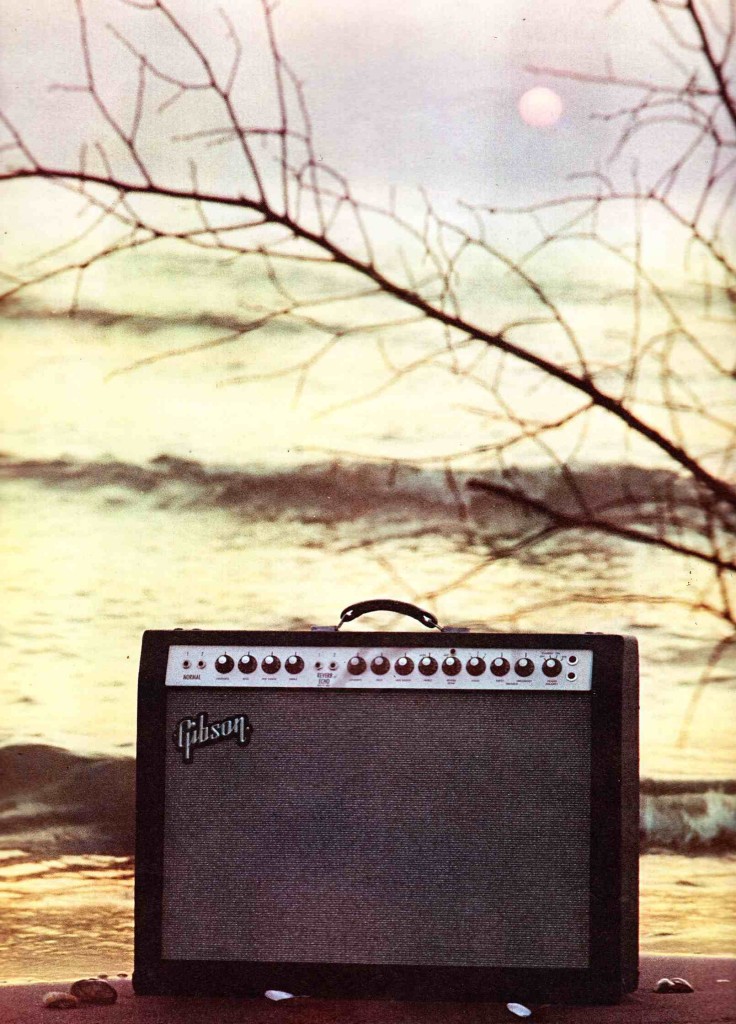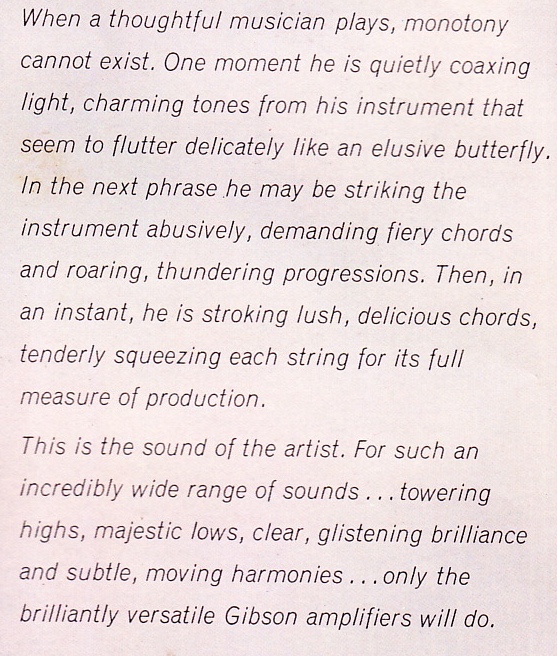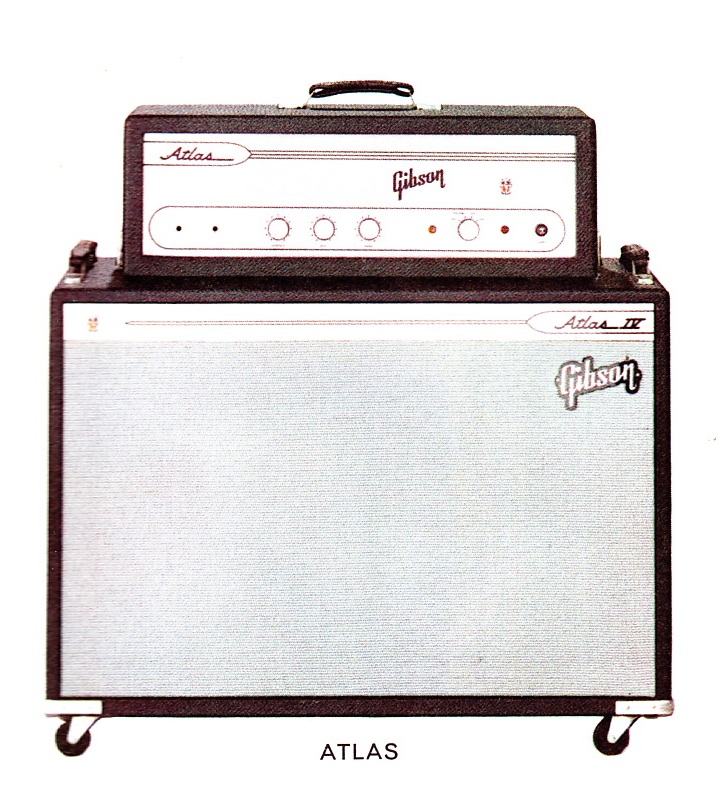 Download a twelve-page scan of the entire guitar-amp line represented in Gibson’s 1966 catalog:
Download a twelve-page scan of the entire guitar-amp line represented in Gibson’s 1966 catalog:
DOWNLOAD: Gibson_amps_1966
Models covered, with specs and photos, include: Gibson GSS-100, GSS-50, and PLUS-50 solid-state amplifiers; Gibson Titan, Mercury, Atlas, and Atlas Medalist (Bass) amps; Vanguard GA-77, Apollo GA-95, Multi-stereo GA-79, Ranger GA-66, and Saturn GA-45 Reverb/Tremolo amps; Lancer GA-35, Minuteman GA-20 RVT, Explorer GA-15 RVT, Recording GA-75 and GA-75L, Skylark GA-5 and GA-5T practice/studio amps.

 Above is some of the most awful product-prose that I have ever encountered, taken directly from p.16 of the 1966 catalog. ‘Butterflies, Stroking, Squeezing the full measure …..’ Were these people fucking high? Actually, the problem is that they probably weren’t high. Yet. 1966 seems to have been a decisive year in musical-instrument marketing; the very last year that manufacturers denied the very existence of Rock and Roll. Most of the catalogs and advertisements from 1966 (and earlier) were very staid, grown-up, and had a romantic rather than… aquarian… sensibility. In 1967 we start to see the bright colors, bold graphic design, and general emphasis on youth that remain in most musical-instrument marketing even today.
Above is some of the most awful product-prose that I have ever encountered, taken directly from p.16 of the 1966 catalog. ‘Butterflies, Stroking, Squeezing the full measure …..’ Were these people fucking high? Actually, the problem is that they probably weren’t high. Yet. 1966 seems to have been a decisive year in musical-instrument marketing; the very last year that manufacturers denied the very existence of Rock and Roll. Most of the catalogs and advertisements from 1966 (and earlier) were very staid, grown-up, and had a romantic rather than… aquarian… sensibility. In 1967 we start to see the bright colors, bold graphic design, and general emphasis on youth that remain in most musical-instrument marketing even today.
 Above, the Gibson Atlas. What a beautiful piece of industrial design this is. After I came across this catalog, I looked for any examples of this unit for sale. I could not find a single one. While I am sure that the Gibson Atlas did not ship in nearly the same numbers as, say, a Fender Bassman, there is another reason that these 60’s Gibson amps are not too common today: reliability and build quality. While Gibson amps of the 1940s-60s are excellent sounding in general, Leo Fender really had these midwesterners beat as far as construction quality. Earlier this month I serviced a couple of early 60s Gibsons for a client. Opening up a mint-condition Gibson circa ’62 student amp… I can’t recall the model, but it was a PP 6AQ5 amp with fixed-depth trem… anyway, opened it up to find a few haphazardly placed terminal strips, and even a few multi-component junctions meeting in mid-air. This is in sharp contract to the build of even the cheapest Fenders, all of which have carefully laid-out, serviceman-friendly terminal boards. The same construction techniques you will find in much military and commercial hardware of the pre-PCB age. This is not surprising when you remember that Leo Fender began his career as a radio repairman rather than as a luthier or musician. As you (IF you) learn to design and build tube audio equipment, take some time to open up as many old pieces of hardware as you can find. $2, $5 pieces… old test equipment, radios, organs… check out the construction and mounting techniques, lead dress, solder joints… you will find a huge variety of techniques used, all of which will have some useful applications in your own work. This is all the stuff that can’t learn from schematics, and certainly not from reading (blogs) online.
Above, the Gibson Atlas. What a beautiful piece of industrial design this is. After I came across this catalog, I looked for any examples of this unit for sale. I could not find a single one. While I am sure that the Gibson Atlas did not ship in nearly the same numbers as, say, a Fender Bassman, there is another reason that these 60’s Gibson amps are not too common today: reliability and build quality. While Gibson amps of the 1940s-60s are excellent sounding in general, Leo Fender really had these midwesterners beat as far as construction quality. Earlier this month I serviced a couple of early 60s Gibsons for a client. Opening up a mint-condition Gibson circa ’62 student amp… I can’t recall the model, but it was a PP 6AQ5 amp with fixed-depth trem… anyway, opened it up to find a few haphazardly placed terminal strips, and even a few multi-component junctions meeting in mid-air. This is in sharp contract to the build of even the cheapest Fenders, all of which have carefully laid-out, serviceman-friendly terminal boards. The same construction techniques you will find in much military and commercial hardware of the pre-PCB age. This is not surprising when you remember that Leo Fender began his career as a radio repairman rather than as a luthier or musician. As you (IF you) learn to design and build tube audio equipment, take some time to open up as many old pieces of hardware as you can find. $2, $5 pieces… old test equipment, radios, organs… check out the construction and mounting techniques, lead dress, solder joints… you will find a huge variety of techniques used, all of which will have some useful applications in your own work. This is all the stuff that can’t learn from schematics, and certainly not from reading (blogs) online.
4 replies on “Gibson Guitar Amplifers: 1966”
The “gold standard” of how to build tube equipment is easily the old Tektronix oscilloscopes, but those are really at an unattainable standard. More relevant are many old pieces of military and 2 way radio equipment.
Yeah, the old Gibson amps were less than well laid out. Some were worse than others. But the main reason they are not as prevalent today is that fewer were sold and more were junked early on when they needed fixing. No one wanted them.
The old DIY magazines like Audiocraft and the various tube and transformer vendors had some good articles on how to lay stuff out. The Mullard book (free at pmillett.com) has some beautiful layouts as do many Brit magazine articles that show up once an a while.
Fender published both schematics and detailed underchasssis layouts that are readily available.
But having the old stuff to look at and compare firsthand is often best.
The ARRl handbooks are sometimes good and sometimes an example of what NOT to do.
Hmmm,
I am Dennis Harris. I have been a bassist since the early 60’s. I am in my 60’s as we speak. I own and continue to play through a 1964 Gibson Atlas Medalist bass amp. I bought it in 1966 from a music store in Georgia. I think it is built like a rock. I did blow the original Jensen 15 inch speaker in about 1969. I replaced it with an aluminum voice coiled “Utah” replacement speaker. The only other thing I have done to it over the years is replace the tubes. I found Sovtek tubes work just right. My transformer does not have the brown “bleeding” like so many Gibsons that I have seen. Unfortunately, my case is pretty beat up. So, I intend to rebuild the wooden case to spec (make it look better). However, I expect the electronics in this amp will last another 50 years without rewiring or any other modification. Bottomline.. Maybe some would say cheap ..but my Gibson Atlas Medalist continues to pass the test of time..Thxs for the forum…
They look so nice the vintage classic and original amps